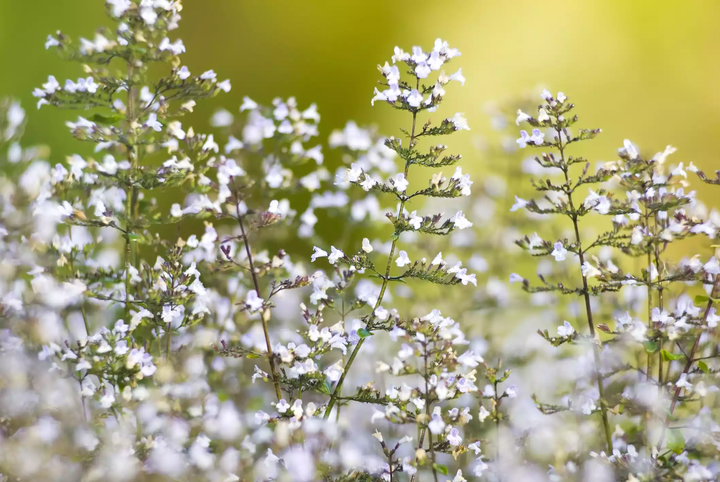There are around eight definite species of calamint, and they all belong to the Lamiaceae (mint) family. They're care requirements, however, are considerably different than that of true mint.
These small, bushy, aromatic perennials are known for being low-maintenance, hardy and versatile. Calamint tend to be drought-resistant, able to grow in any soil type and can handle being positioned in shady locations. Most calamints are low-lying, not growing to be more than 24 inches in height, and they can bloom at different times of the year.
The pretty and fragrant calamint flowers grow in small clusters and come in a range of colors, including white, purple, pink and red. Known for being attractive to pollinators they're well-suited to cottage and herb gardens, and perennial borders. Calamints drought-tolerance and ability to grow in infertile soils means they're also a popular addition in xeriscape landscapes.
Their ability to rapidly reseed, though, can be a hindrance in some gardens. To avoid them taking over a space, careful pruning of the flower heads will be needed before they seed. You could also confine them to container growth, use landscaping fabric or, more simply, select a hybrid cultivar that is sterile. The leaves of some calamint can be harvested for use in cooking or for refreshing teas.
There are at least another twenty or so plants that are sometimes also lumped into the Calamintha genus. This is because there have been several shuffles of taxonomy over the years. There are still debates, even amongst experts, about which fall under the genus and those that don't.

How to Grow Calamint
Calamint are versatile and relatively low-maintenance little flowers that can tolerate a variety of soil types, lighting and temperatures.
Light
These species can thrive in full sun or partial shade locations. In areas that have strong afternoon sun, calamint will do better being planted in a shadier spot.
Soil
Known for being able to adapt to pretty much any soil type, calamint can grow in infertile, gravelly, loamy and sandy varieties without issue. It just needs to be one that has good drainage.
Water
Calamint likes to be kept consistently moist, but it copes surprisingly well through periods of drought. To prevent stress in prolonged drought conditions, where possible, you should still lightly water your calamint after the top inch of soil has dried out. Overwatering, however, is a bigger problem. Calamint roots don't like to be sitting in standing water.
Temperature and Humidity
If you experience chilly winters, calamint could be suited to your garden. They're relatively cold hardy and can survive even when temperatures reach almost as low as 0°F.
This isn't a plant that appreciates extreme heat or humidity.
Fertilizer
Unless they're planted in highly infertile soil, your calamint won't need any fertilization. If the soil is particularly deficient in nutrients, applying a balanced fertilizer just once at the start of the spring could help to increase the plant's vigor.
Propagating Calamint
Calamint has long, spreading rhizomatous roots, and these can be easily divided or cut to develop new plants.
It's best to take any healthy cuttings in the spring, after the last frosts, and make sure they're kept moist but well-drained during their establishment period. They should also be protected from too much harsh, direct sunlight.
Varieties of Calamint
There are at least eight species of calamint and many hybrid cultivars too.
Some of the most common varieties include:
Calamintha nepeta (lesser calamint) - one of the most popular options, it flowers abundantly, has a pleasant fragrance, and is fast-spreading. The blooms are usually white but can sometimes be purple or blue.
Calamintha grandiflora (mint savory) - Often selected because it has larger flowers than most of the other species in this genus. Available with variegated foliage, it also smells delicious. Mint savory isn't a fan of direct sun, definitely preferring a partial shade position.
Calamintha sylvatica - This lilac-flowered variety can cope with higher temperatures better than other species in the genus. It also produces a particularly flavourful tea.
Calamintha nepeta ‘Montrose White’ - this hybrid variety is sterile, making it a good choice if you don't want to deal with the spread of these plants.

Pruning
Deadheading the flowers before they start to seed in late summer or early fall is important if you want to control your calamints spread.
Trimming back the plant to half height after the growing season can also encourage new spring growth and keep this bushy perennial from looking untidy. It can also redirect the energy needed to encourage more vigorous blooming.
Harvesting
Calamint tea is known for being fresh, fragrant and sweet, and it's also said that it can help aid healthy digestion. The leaves are often used in a variety of cooking recipes too.
You can harvest the leaves from your calamint plants anytime through their growing season from late spring to early fall.
Picking the leaves at the start of the season and first thing in the morning is recommended for the fullest flavors.
Growing From Seeds
Calamint is fairly easy to grow from seeds. To ensure temperatures remain mild enough, it's best to sow seeds indoors or in a greenhouse. This should be done in early spring, and you'll need a moist and well-drained medium.
They don't take long to germinate, and you should start to see growth within a couple of weeks and, with the right conditions, blooming could occur after just a few months.